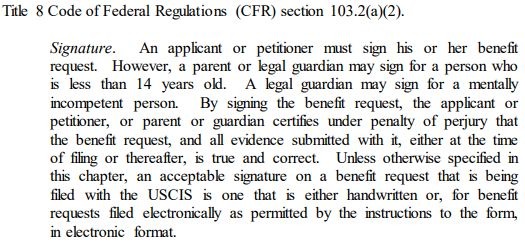- Introduction
- Applicable Regulation
- Policy Background
- Signature Requirements
- Who Must Sign a Request or Document Submitted to USCIS (Individuals)
- Who Must Sign a Request or Document Submitted to USCIS (Employees Within Corporation or Legal Entity)
- Effect of a Signature
- Purpose of the Form G-28
- Form Revisions
- Conclusion
Introduction
On February 15, 2018, the United States Citizenship and Immigration Services (USCIS) issued Policy Memorandum (PM)-602-0134.1, titled “Signatures on Paper Applications, Petitions, Requests, and Other Documents Filed with U.S. Citizenship and Immigration Services” [PDF version]. The PM-602-0134.1 finalizes the guidance in an interim memorandum released on June 7, 2017, which had the same title [PDF version (prior interim memo)].
The new PM contains the current USCIS policy regarding “the signature requirement for applications, petitions, requests, and other documents that require a signature prior to filing with the USCIS.” However, it is important to note that the PM contains no guidance or rules regarding electronic signatures for any document that is filed electronically with the USCIS. The PM states that the USCIS will issue guidance regarding electronic signatures at a later date.
In this article, we will examine and discuss the new PM regarding the USCIS’s guidance for signatures on paper documents.
Applicable Regulation
The rules regarding signatures for USCIS forms are found in the Code of Federal Regulations (C.F.R.) at 8 C.F.R. 103.2(a)(2). The PM excerpted the pertinent regulation, which we have included below for your convenience:

The purpose of the PM is to provide guidance on how the USCIS will apply the foregoing regulatory language to USCIS forms, excluding those that require electronic signatures.
Policy Background
As we noted in the introduction, the USCIS released an interim PM with the same name and subject-matter on June 21, 2016. The policy guidance in the instant PM supersedes the June 21, 2016 PM in its entirety.
The new PM made one change regarding the signing of documents under the Power of Attorney (POA) under general agency principles (note: “agency” refers to an agent signing documents on behalf of a principal under a POA, not to a government agency). Under the instant PM, the USCIS will not accept documents signed under general agency principles under a POA. We will discuss this further in the section of this article dealing with POAs.
Other than the one change regarding POAs, the guidance in the instant PM is identical to that of the 2016 interim PM.
Signature Requirements
The PM begins by stating that the USCIS requires a valid signature on any USCIS application, petition, request, or certain other documents. An individual filing a request with the USCIS — which refers “to any written request for an immigration benefit, service, or request for action, whether the request is submitted on an [Office of Management and Budget (OMB)]-approved form or is an informal written request submitted to USCIS” — must sign his or her valid signature on the request before filing it with the USCIS. The only exceptions to this rule are those specifically authorized in the regulations, by the PM, or in the applicable form instructions.
The USCIS defines a “valid signature” as “any handwritten mark or sign made by an individual” to signify that the individual (quoted):
Knows of the content of the request and any supporting documents;
Has reviewed and approves of any information contained in such request and any supporting documents; and
Certifies under penalty of perjury that the request and any other supporting documents are true and correct.
Because of the purpose of a valid signature, the USCIS explains that the signature “does not need to be legible or in English…” The signature may be abbreviated provided that it “is consistent with how the individual normally signs his or her name.” There is no requirement that a valid signature be written in cursive. Individuals who are unable to write in any language are permitted to “place an ‘X’ or similar mark instead of a signature.”
The OM states that a signature remains valid “even if the original signature is later photocopied, scanned, faxed, or similarly reproduced.” However, unless otherwise specified in the PM or in applicable form instructions, “the copy must be of an original document containing a handwritten, ink signature…” The PM notes that “[t]he regulations [in 8 C.F.R. 103.2(b)(4)] do not require that a requester submit an ‘original’ or ‘wet ink’ signature on a petition, application, or other request to USCIS.”
The USCIS will not under any circumstance “accept signatures created by a typewriter, word processor, stamp, auto-pen, or similar device.”
The USCIS will not process requests that do not meet the signature requirement. If the USCIS determines that the signature on a request is invalid, the USCIS will consider the request to be unsigned. Under 8 C.F.R. 103.2(a)(7), the USCIS rejects and returns unsigned requests. If the USCIS accepts a request for adjudication but subsequently determines that the signature is either missing or that the provided “signature” is deficient, the USCIS will deny the request on this basis. In cases where the signature is determined to have not been properly provided at the time of submission, the USCIS will not provide the requester with the opportunity to “cure” the signature deficiency.
In a case where the USCIS needs additional information when adjudicating a request to verify that the individual who provided a signature is authorized to act on behalf of an individual, corporation, or other legal entity, it may issue either a Request for Evidence (RFE) or a Notice of Intent to Deny (NOID) to determine whether the individual was so authorized at the time the document was submitted to the USCIS.
Who Must Sign a Request or Document Submitted to USCIS (Individuals)
Where an individual files a request or other document with the USCIS, the individual must personally sign the request or document.
The USCIS clarifies that the term “individual,” as used above, “excludes corporations or other legal entities as well as attorneys, accredited representatives, agents, preparers, and interpreters.” Regarding “agents,” the PM clarifies that the use of the term here does not address agents who are filing forms as a petitioner on behalf of a corporation or other legal entity seeking H, O, or P nonimmigrant status on behalf of a foreign national.
The only exceptions to the above rule that the requester must sign a request or document submitted to the USCIS is where the requester is a child who is less than 14 years of age or where the requester is mentally incompetent. In the case of a child who is less than 14 years of age, either the child’s parent or legal guardian may sign the request. Where the requester is mentally incompetent, a legal guardian may sign.
A “legal guardian” is defined for the purpose of USCIS signature policy in the PM as “a person who a proper court or public authority has designated as the applicant’s legal guardian or surrogate and who is authorized to exercise legal authority over the applicant’s affairs.” This definition applies both for situations where the applicant is less than 14 years of age or where the applicant is mentally incompetent. The key point in whether an individual is a “legal guardian” as defined in the PM is whether “the appropriate court or public authority has given an individual this authority…” Accordingly, such an individual will be considered a legal guardian even “if the law of the jurisdiction refers to the individual as ‘conservator,’ committee,’ ‘tutor,’ or other title designating an appointed surrogate.”
The term “legal guardian” does not include individuals who were not appointed by a proper court or public authority. This means that some individuals who may have a legitimate interest in the child or incapacitated adult — including those acting in loco parentis or family members — cannot sign for an applicant if they have not been recognized as a legal guardian.
In order to accept a legal guardian signature, the USCIS requires documentation that establishes the legal guardian’s authority to sign a USCIS request on behalf of the child or mentally incompetent individual. The PM explains that this documentation may come in the form of “official letters of guardianship or other orders issued by a government agency or court authorized to make such appointments under the law governing the place where the child or incapacitated adult resides.” The PM notes that this list is not exhaustive, and that other types of documentation may be used to attempt to establish legal guardianship.
There is a limited scenario in which a formal court appointment is not required in order to establish the authority of an individual to sign on behalf of an incapacitated adult. In this scenario, an individual may sign on behalf of an incapacitated adult “under the authority of a POA or a similar legally binding document.” The PM explains that in this case, “the POA must be durable, meaning that the POA states that it remains in effect if the person becomes incapacitated and unable to handle matters on their own.” Accordingly, the copy of the durable POA must be included with the immigration benefit request along with evidence establishing that the POA is in effect as a result of the incapacitated adult’s disability. The PM suggested that in certain cases, a physician’s statement may establish that a POA is in effect.
If the individual who is signing the request on behalf of the applicant is acting as the applicant’s attorney or accredited representative in dealing with the Department of Homeland Security (DHS) for immigration matters, the individual must submit a Form G-28, Notice of Entry of Appearance as Attorney or Accredited Representative, in accordance with the form instructions and the regulatory requirements found in 8 C.F.R. 292.
The PM makes clear that the USCIS will only accept a POA “if it complies with the state laws governing the jurisdiction in which it was executed.” The requester bears the burden of establishing that these requirements are met.
Who Must Sign a Request or Document Submitted to USCIS (Employees Within Corporation or Legal Entity)
The PM explains that the Immigration and Nationality Act (INA) permits corporations and other legal entities (e.g., professional corporations, limited liability companies, and limited liability partnerships) to file certain requests with the USCIS. These provisions generally pertain to employment-based nonimmigrant and immigrant visa petitions filed on behalf of foreign nationals (including requests to “extend a petition’s validity period and the authorized period of stay for a current nonimmigrant worker”).
It is not the case that any individual within such an entity may sign a request on behalf of the entity. The individual must fall within a specific class of authorized individuals. The PM lists examples of such “authorized individuals” (quoted):
1. An executive officer of a corporation or P.C. with authority to act on behalf of the corporate entity and legally bind and commit the corporate entity in all matters (such as the chief executive officer, president, vice president);
2. A managing member or managing partner of an LLC or LLP;
3. A duly authorized partner of a partnership;
4. An attorney employed in an employer-employee relationship by the corporation or other legal entity as its legal representative or as a legal representative by the corporation or other legal entity’s legal department in an employer-employee relationship (such as in-house counsel or other attorney employees);
5. A person employed in an employer-employee-relationship as a human resources professional within the entity’s human resources, human capital, employee relations, personnel, or similar department who is authorized to sign legal documents on behalf of the corporation or other legal entity;
6. An executor or administrator of an estate;
7. A trustee of a trust or a properly appointed conservator; or
8. Any other person employed in an employer-employee relationship by the corporation or other legal entity who has the authority to legally bind and commit the corporation or other legal entity to the terms and conditions attached to the specific request and attestations made in the request. It does not matter what this person’s title is or the name of this person’s department with the corporation or other legal entity.
The PM notes that point 8 does not address situations in which agents are permitted to act as petitioners for a corporation or other legal entity seeking to accord H, O, or P nonimmigrant status.
Before continuing, it is important to note that the foregoing points in this section do not apply to sole proprietorships. The owner of a sole proprietorship is required to sign any request as an individual.
When an individual signs a USCIS request on behalf of a corporation or other legal entity, “the form must contain a statement by the individual signing the request, affirming that he or she has the legal authority to file the request on the petitioning employer’s behalf[,] that the employer is aware of all of the facts stated in the request, and that such factual statements are complete, true, and correct.”
Where affirmation from the individual signing the request is included with the form, the signature by the individual filing the form may suffice for meeting the signature requirement. However, if the affirmation is not included in the document, the USCIS “will require a separate statement from the person signing the form or document affirming that he or she has the authority to legally bind the corporation or legal entity.”
If the USCIS has any reason to doubt that the individual signing the request has the authority to sign or act on behalf of the corporation or other legal entity, it may, in its discretion, request evidence supporting the individual’s authority. The evidence may include, but is not limited to:
Bylaws;
Articles of organization;
A letter reflecting delegation of such authority from a corporate officer or board member;
Board of director’s minutes reflecting the grant or the board’s approval of such authority being exercised by the individual in question; or
A similar document that indicates the employee may legally bind the corporation or other legal entity with his or her signature.
Effect of a Signature
By signing a request or document submitted to the USCIS, the individual signing the request or document affirms that he or she “has the authority to sign the document, has knowledge of the facts being represented in the document, and attests to the veracity of the facts and claims made in the document.” Thus, any individual who signs the request or document will be held personally accountable for any fraud and/or material representation. This liability extends to those who sign documents on behalf of a child or mentally incompetent person and those who sign documents on behalf of a corporation or other legal entity.
Purpose of the Form G-28
When an attorney or accredited representative submits a Form G-28 to the USCIS, “he or she is certifying that the individual, corporation, or other legal entity in the Form G-28 has authorized the attorney/accredited representative to act on the individual’s or other legal entity’s behalf when filing requests or other documents with USCIS.” The PM reiterates, however, that the Form G-28 itself does not authorize the attorney or accredited representative to sign a request or other document on the individual’s, corporation’s, or other legal entity’s behalf. The PM adds that an attorney or accredited representative “may not use a POA to sign a Form G-28 on behalf of an individual, corporation, or other legal entity to authorize his or her own appearance.”
Form Revisions
The PM notes that the USCIS may specify in the instructions for each USCIS form specific guidelines regarding signatures, including “what evidence must be submitted to establish that someone signing a document instead of the requestor has the authority to act on a requestor’s behalf.” Individuals filing forms must carefully follow the form instructions, including with regard to the signature requirements. The PM states that “[i]f a form contains no clear signature authority requirements or limitations, then the policy in this PM applies.”
Conclusion
The new PM on signature requirements generally re-codifies policies from the interim PM issued in 2016. In general, individuals must sign any request they submit to the USCIS, certifying their authority to sign the request and attesting to knowledge of the facts and claims contained within and to the veracity of the facts and claims. In the case of a corporation or other entity, the signature must be issued by an individual with authority to legally bind the corporation or other entity. One of the most noteworthy points in the PM is its guidance regarding situations in which an individual may sign on behalf of a child less than 14 years of age or on behalf of an incapacitated or mentally incompetent adult.
In general, those filing applications or requests with the USCIS are well advised to consult with an experienced immigration attorney. An attorney may guide them through the entire process and ensure that all requirements are properly met, including the signature requirement. Notwithstanding the general guidance in the PM, those filing any form with the USCIS must carefully follow the form instructions and carefully and truthfully complete all required fields.





